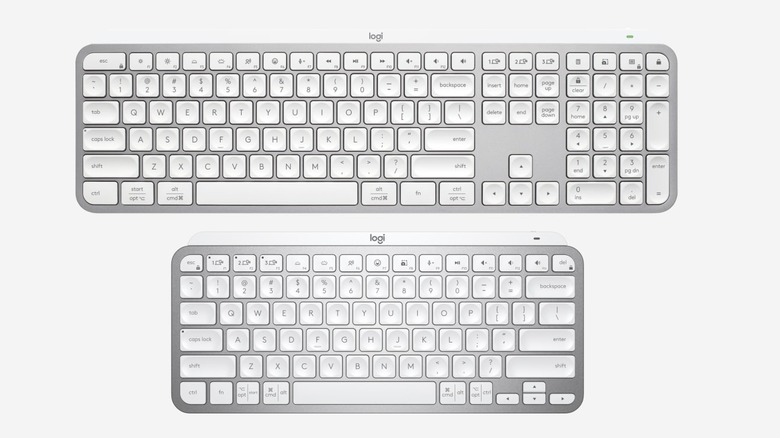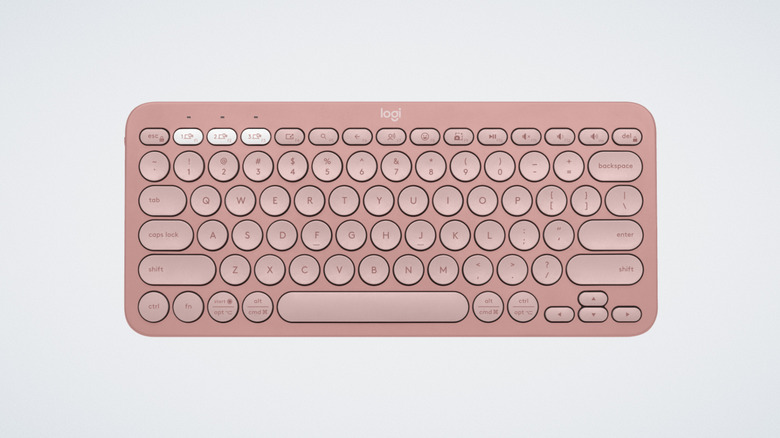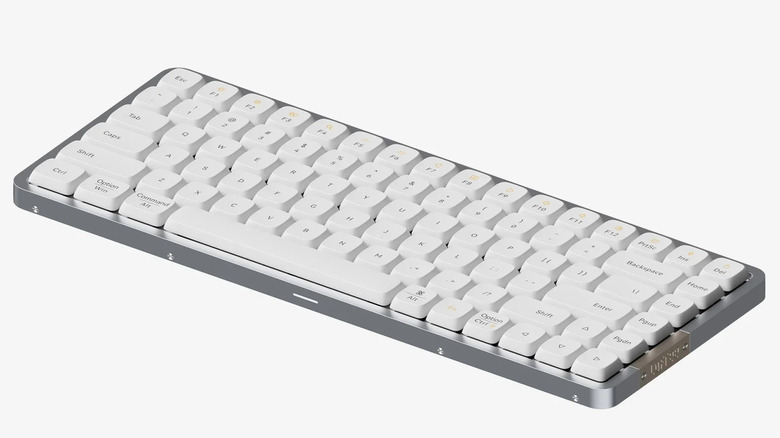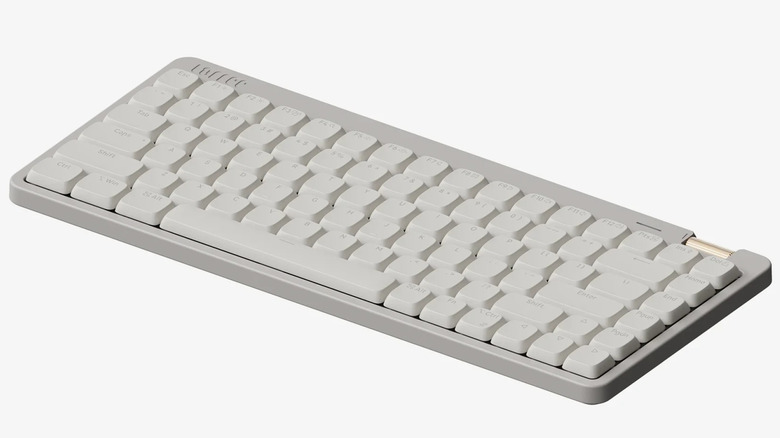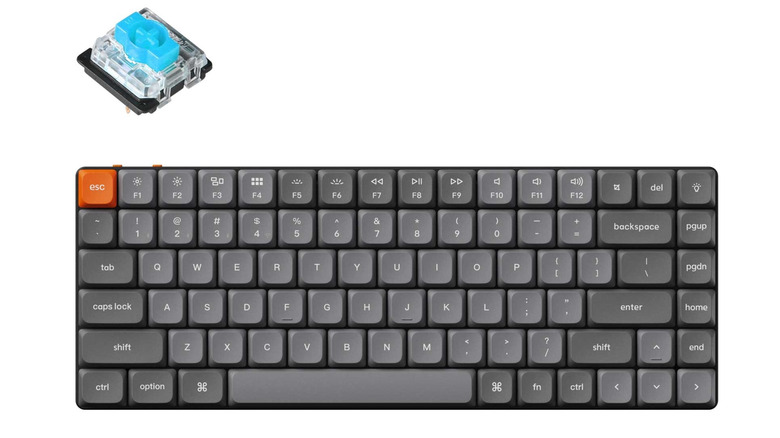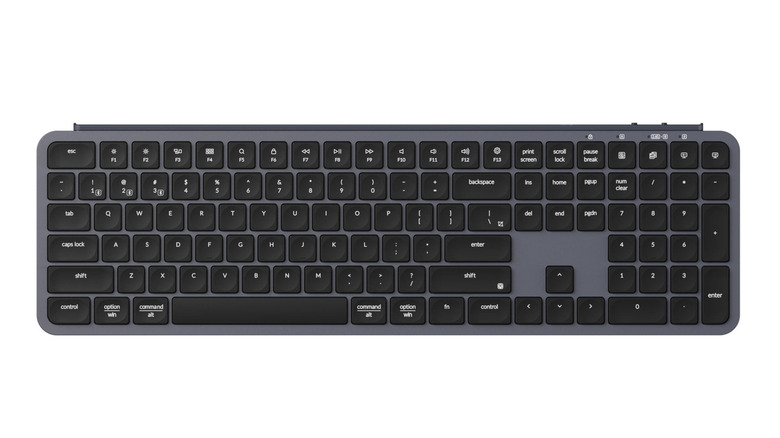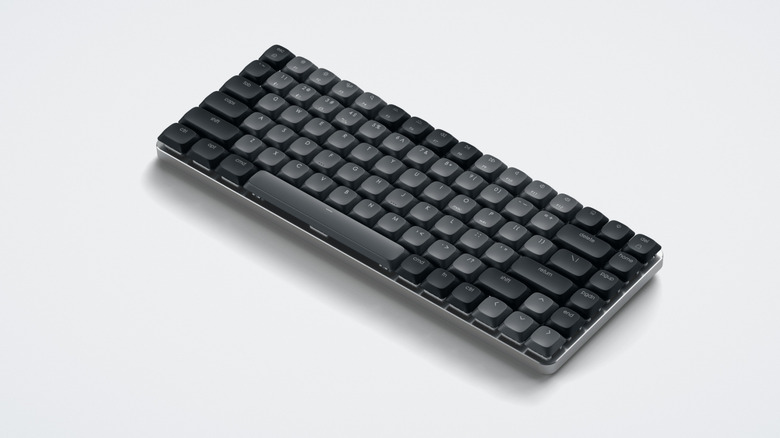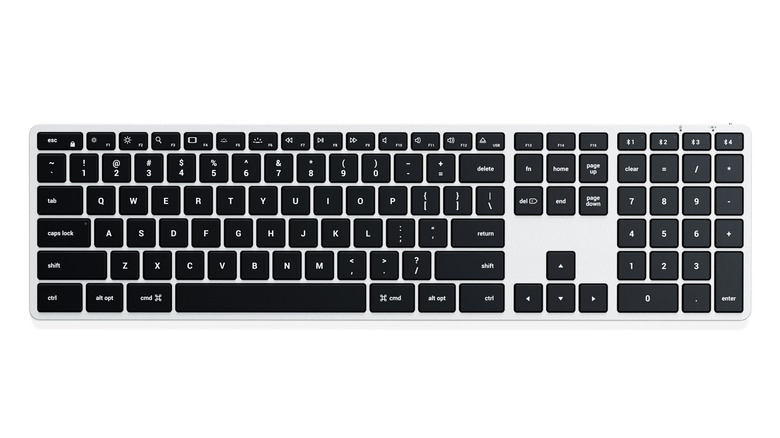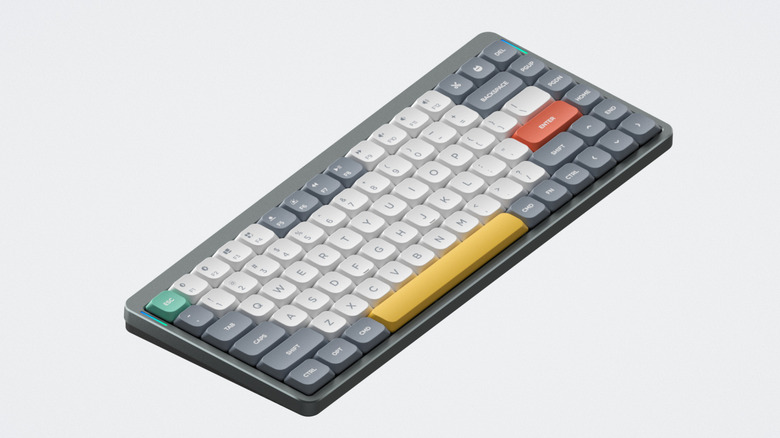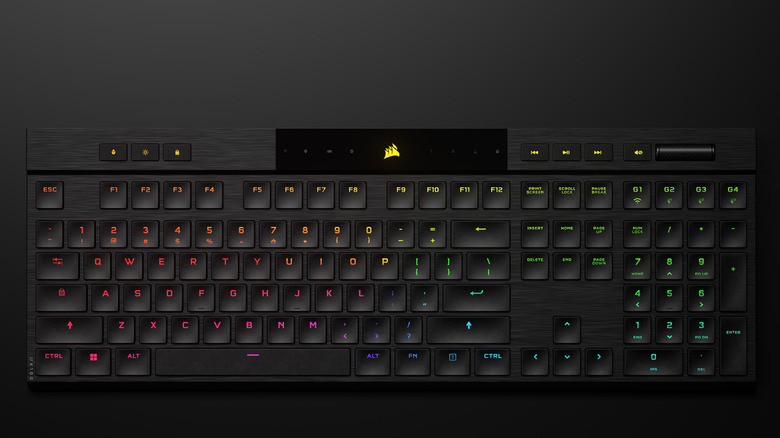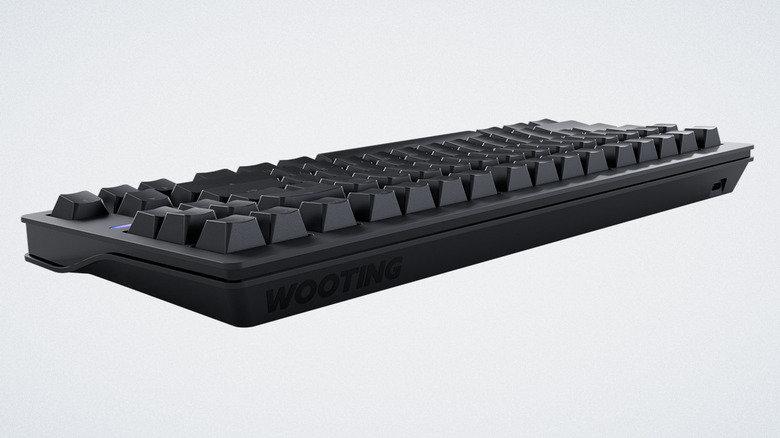12 Low-Profile Alternatives To Apple's Magic Keyboard
When buying a desktop Mac (like the new, small Mac Mini M4), it might be tempting to grab the Apple Magic Keyboard to complete your setup. After all, it uses the same minimalistic design language, is razor-thin and light, and (in the case of the larger Magic Keyboard with Touch ID) includes a fingerprint scanner for quickly unlocking your device. That's about where the benefits of the keyboard run out. It's painfully expensive ($99 for the base Magic Keyboard), features no backlight, and even lacks simple features like a keyboard stand. There are a plethora of ergonomic mouse options currently available to replace the carpal-tunnel-inducing Apple Mouse. So what about the keyboard?
Keyboards, if you can believe it, have become wildly popular in the past few years, especially mechanical ones. Those who have one attest that it doesn't just make you more efficient while hunched over your desk, it makes the humdrum of typing actually kinda enjoyable. We've already covered the best keyboards on Amazon for every budget and style. So now we're looking at low-profile keyboards — whether mechanical or standard membrane — that are so good you won't miss Apple's expensive, under-featured offering. Here are 12 for every use case, budget, and aesthetic preference.
Logitech MX Keys S
Logitech is arguably the king of peripherals, so it comes as no surprise that its flagship Logitech MX Keys S makes for an excellent Apple Magic Keyboard alternative. It even looks like a distant cousin of the latter. There are two variants: the Logitech MX Keys S for $109.99, and the Logitech MX Mini for $99.99. The Mini is a 75% keyboard, so no numpad. Those who would rather not wake everyone in a 100-meter radius with their typing will enjoy the quiet scissor key presses and "spherically-dished" keys; they have a concave depression for your fingers to fall into naturally. I own the MX Keys S, and typing with it is a dream. Being able to pair it to three separate devices with a one-button press is also greatly appreciated.
Probably the coolest feature is the battery-saving automatic backlight, which turns on when it detects your hands nearby. This feature is a bit hit or miss, and it often leaves the backlight on even when the computer isn't in use. But when it does work, it's extremely helpful in a dark office at night. Another noteworthy downside is that it doesn't support any form of wired mode. Wired keyboards and mice are better for gaming since they have lower latency. Look elsewhere if this will double as your Mac's gaming peripherals. Finally, the MX Keys S in particular is a bit on the heavy side. Even with those disadvantages, this is a rock-solid keyboard that will last you for years.
Logitech Pebble Keys 2 K380s
If you're a big fan of Logitech but put off by the steep price of the Logitech MX Keys S, then maybe try the Pebble Keys 2 K380s for $39.99. You'll be giving up the backlight and the MX Keys S's super-smooth scissor keys, but this is a great keyboard for the price. It still supports the same three buttons for pairing different devices, quiet typing, and all the function keys you'd expect from a 75% keyboard. Logitech advertises this more as a travel-friendly keyboard than one meant strictly for your desk, so it's ideal for picking up and going.
One issue with the Logitech MX Keys S (and any Bluetooth keyboard that has a backlight) is that the battery only lasts about a week. Not so with the Pebble Keys 2, which boasts up to 36 months of battery life. There's also one additional color option: tonal rose. Those who need a keyboard that works with an iPad Pro M4 or Android tablet can use this one straight out of the box. If nothing else, you'll at least feel better about your commitment to the environment, since the Pebble Keys 2 is made from 50% recycled plastic.
Lofree Flow84
The mechanical keyboards we mentioned earlier might evoke images of chunky, analog-looking peripherals, but you'd be surprised how many low-profile variants the most reliable mechanical keyboard brands make. One up-and-comer in the mechanical keyboard space is Lofree. At first glance, its Lofree Flow84 doesn't look like a mechanical keyboard at all. The hot-swappable mechanical keys fit tightly into the aluminum-alloy body of a 75% frame, with a backlight and RGB to boot. Measured from the side, it's only 26mm thick.
Having used this one in person, I can assure you it oozes style and luxury. The keys sound great, and it's shockingly light and compact. It supports Bluetooth and wired mode, up to three devices, and offers two different switch types: linear and tactile. Function keys are reprogrammable through the Lofree Key Mapper (though currently only on Windows). Those in search of the tactile mechanical typing experience and key travel (great for video games) will find it here. Backlight life is good at about 40 hours, and I'm told, anecdotally, that it lasts weeks with the backlight disabled.
There's only one downside to consider: the price. This is one of the most expensive mechanical keyboards on the list at $159 for 84 keys, and $169 for the Flow100 (100 keys). That said, you're getting your money's worth with the quality of the construction and parts.
Lofree Flow Lite84
Just as the Logitech Pebble Keys 2 was the cheaper alternative to the MX Keys S, the Lofree Lite84 is a lower-priced alter ego to the standard Flow84. So what gets the axe to bring the price down to $129? Not much. It seems the reduction is mostly thanks to the switch to plastic materials. In fact, the Flow Lite84 has several features that outshine its Flow84 older brother.
First, you get a more intuitive roller volume control, a flip-out kickstand, ABS material that Lofree claims is more "soothing" to the skin, as well as new POM switches and shine-through keycaps. The backlight isn't under the keys like on the regular Flow. The Flow Lite even includes a low-latency 2.4 GHz dongle, which the earlier model does not support.
Lofree seems to have made incremental improvements across the board over the previous version, such as putting the Flow Lite84 at a lower angle and tweaking the typing sounds. Battery life is also improved, with a whopping 80 hours on a single charge. You will be giving up some small perks, such as RGB lighting, the multi-mode backlight, and the choice of tactile switches. But on the whole, this is 99% of the regular Flow for about $30 less. Your decision will mostly come down to choosing between aluminum-alloy and plastic.
Keychron K3 Max
We took a look at the Keychron Q1 HE and gave it a full 10/10, but that's not a low-profile keyboard. For that, you should check out the Keychron K3 Max. It's another 75% keyboard, with the cheapest white backlight version coming in at $94.00 — and it gives the Lofree a run for its money by removing the border around the keys to look even slimmer. Thickness-wise, it's an impressive 22 mm and 1.16 pounds. Despite this, it still gets about 42 hours of battery on the low-brightness backlight setting, or 73 hours with the backlight off.
For connectivity, you've got 2.4 GHz and Bluetooth, and a competitive 1000 Hz polling rate. The backlight on the Keychron K3 Max shines through the keys, with a more expensive option boasting full keyboard RGB. One leg up the K3 Max has over Lofree is an open-source, web-based key remapping client that works on all platforms. Keys are hot-swappable, and that might be a necessity if you want white keys to better match your Mac, since the K3 Max only ships in its gray-orange colorway. At this price point, with everything you get in such a slim package, there's not much to complain about.
Keychron B6 Pro Ultra-Slim
Of course, spending $94 on a keyboard is unthinkable for some people. Keychron makes the more budget-friendly B6 Pro Ultra-Slim for $44.99 if the earlier prices have set your teeth on edge. If you liked the look of the Logitech MX Keys S, then this will be right up your alley since it's quite similar in appearance. Unlike previous entries on this list, this is not a mechanical keyboard, but rather a membrane with scissor keys like the Logitech — and likewise incredibly slim at 14.5 millimeters. There's no backlight on this version, and as a result, Keychron estimates that you can get about eight months on a single charge.
So who is the Keychron B6 Pro for? Probably anyone who liked the look and feel of the Logitech MX Keys S but didn't like the price. The B6 Pro even has the same concave keys, just to show how much they share in common. As an added bonus, Keychron gives you a reusable protective silicone skin so your keyboard doesn't gather dust when you step away from the desk for the day. Not a bad offering for the price.
Satechi SM1 Slim
Almost identical in appearance to the Keychron K3 Max (aside from the colorways) is the Satechi SM1 Slim. Although it's a touch above the Keychron at $99.99, the price seems to be justified. In line with its competitors, it's an incredibly slim 24 mm, sporting tactile mechanical switches — although these are soldered in. Unlike most on this list, the SM1 Slim can connect to a total of four devices rather than three via Bluetooth, or via 2.4 GHz with the USB receiver. Another plus is the adjustable feet, helping you find the perfect angle to protect your wrists. The backlight features 14 different patterns; it shines in blocky patterns with individual keys to create a sort of miniature light show. Although gimmicky, it's something to note.
Battery life is probably the weakest aspect of the Satechi. With the backlight on, you only get about 16.5 hours, although this extends to two months when turned off. That's basically two full workdays of battery, which — even among backlit keyboards — is quite low. Pricing could also be better, considering how many keyboards there are at this price point and how many features they cram in. The fact it can connect to four devices might be its biggest selling point, but in any case, it's nice to see the added competition.
Satechi Slim W3 Wired
As mentioned, one of my biggest gripes about the Logitech MX Keys S is the lack of a wired-only mode. Most on this list add it as a feature, but what if you want a wired-only keyboard with no battery to speak of — just like the good ol' days? Try the Satechi Slim W3 on for size. This is another full-sized keyboard (like the Keychron P6 Pro Ultra-Slim) that is very close in appearance to the Apple Magic Keyboard. Plus, a backlight. Since it's plugged in, you won't ever have to worry about the battery dying after a measly week of work.
At the expense of being able to use the keyboard cable-free, the Slim W3 does shave off a lot of weight. Most on this list sit in the 1.5 lbs range compared to 0.97 pounds here. Importantly, this is a Mac-oriented keyboard with keys that don't feel bloated trying to cram Windows and Mac input labels together. Make sure you have a USB-C port on your computer before getting this — ideally Thunderbolt 3 or USB4/USB 3.2 Gen2. The only significant downside we can see is the price: The Slim W3 costs $69.99, despite being a relatively limited offering versus everything we've discussed so far.
NuPhy Air75 V2
If you thought you'd seen all the major competitors in the mechanical keyboard space, then get ready for another. NuPhy's Air75 V2 is neck-and-neck with Lofree, Keychron, and Satechi as far as pricing and features go. NuPhy goes to great lengths to emphasize the many lessons they've learned over the years, tweaking and refining their keyboards. Design is the key word here — the colorful spacebar and Enter keys on white-and-gray keys certainly make it stand out from the pack.
The NuPhy is for people who like taking their electronics apart to look at the pretty insides, because even internal components like the battery match the colorway. Gamers who hate messy cables will love it too; the Air75 V2 claims its wireless mode is almost indistinguishable from wired, thanks to a 1,000 Hz polling rate over 2.4 GHz. It supports wired mode, works with up to four devices, and lets you remap the keys from your web browser, no app needed. One of the coolest features, though, is how the feet on the keyboard are designed so you can place it on top of your MacBook's keyboard and use it instead.
There's not much to criticize about the Air75 V2. The $119.95 price puts it in line with others on this list, aided by the fact it comes with some free replacement switches and a switch remover tool. Battery life is also in the same ballpark — up to 57 hours with the backlight on and 220 hours (about 9 days) with it off.
Corsair K100 Air
Gaming brands have to keep up with mechanical keyboards because, for heavy-duty gaming, mechanical keyboards are practically essential. We've discussed whether MSI mechanical keyboards are any good, but Corsair has dipped its feet in these waters as well with its Corsair K100 Air Wireless. In typical fashion for a gaming company, they've gone all out on a premium, RGB-lit keyboard for $279.99. No expense has been spared.
Roundly beating the competition, you can pair the K100 to five devices via an encrypted connection or use it in wired mode; customize the RGB coloring of every single key; control the volume with the scroll wheel; and save up to 50 unique keyboard profiles on the device rather than your computer. It even comes with a fancy braided cable for wired mode. Perhaps most surprisingly, it only weighs 1.27 pounds, right in line with the options on this list. If that wasn't enough, the full keyboard's brushed aluminum frame even makes it feel like one of James Bond's cars.
To be clear, this is a keyboard meant primarily for gamers, with all the RGB lighting, tactile switch tech, and a class-leading 8,000 Hz polling rate. High polling doesn't mean much if you're just typing. Since gaming on a MacBook Pro is an awkward situation, this keyboard is really only justifiable if your Mac is your daily driver and you've got a Wintendo gaming PC on the side — or if you're optimistic about the future of macOS gaming. You'd be getting 95% of the Corsair's features with other keyboards that are half the price.
iQunix Magi65
It's not quite clear how you pronounce iQunix, but the iQunix Magi65 is clearly set to appeal to many. This 65% keyboard sets itself apart with its distinct keycap designs and the curious Pro-only switches. Everything (according to IQunix) is top-notch, from the space-grade, anodized aluminum to the wear-resistant, anti-oil PBT keycaps. You've got wired connectivity with USB Type-C, as well as Bluetooth 5.1 and 2.4 GHz. It's one of the few on this list, like the Corsair, that has per-key RGB lighting. The Le-tray system dampens key presses for better typing comfort and reduced noise. Although it's 65%, the pricing is in line with everything here at $119.
Upgrading to the Magi65 Pro for $139 gets you the most distinctive aspect of the Magi65: the add-on media controls. There's a volume scroll bar, media buttons, and a top-facing storage slot for the 2.4 GHz dongle. Battery life is acceptable as mechanical keyboards go at 300 hours with no backlight, which translates to about 12 days of use. One considerable downside worth mentioning is that the keyboard weighs about 1.98 pounds (900 grams), which makes it less ideal for travel. Barring that, the iQunix makes an excellent choice for typers and gamers alike.
Wooting 80HE
Wooting caught our eye not just because of its bizarre name, but the satirical promotion video for its newest Wooting 80HE keyboard. In it, the brand's CEO pokes fun at YouTube gamers and reviewers, promising that its keyboard can actually support the features it claims to have. After a successful Kickstarter, the brand raised over 7 million euros, and the 80% layout Wooting 80HE is now available for sale.
What sets it apart? First, the 8,000 Hz polling rate. This rate is the gold standard — one that costs you a pretty penny, as the Corsair has demonstrated. Then there are all the gamer-oriented features: adjustable actuation, rapid trigger, and the so-called "Rappy Snappy" for competitive online gaming. Similar to the iQunix, there's a switch plate and silicone gasket to reduce noise and make typing less stressful on the fingers. Add on an LED bar and per-key RGB, and there's not much else missing. Like the Corsair, the Wootility remapping software saves your configurations to the keyboard itself.
In case it wasn't clear, this is a gaming-first keyboard. macOS support is also not automatic, so you'll need to do a couple of remappings to properly place your Option and Command keys. Since this is a young company that did its funding through Kickstarter, you'll have to accept a fairly high asking price at $199.99 — but for all that's included, you're getting a lot of bang for your buck.

